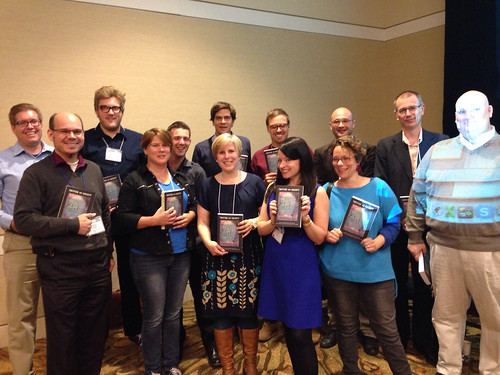

The book is a 450-page anthology of the very best of current Twitter research, providing a comprehensive overview of research methods, concepts, challenges, and applications. It features some 31 chapters, a foreword by the University of Amsterdam’s Richard Rogers – and we’re particularly proud to have been able to use the painting Die Zwitschermaschine (The Twittering Machine) by Paul Klee as the book cover. Many, many thanks to our 45 contributors for their fabulous contributions. A full list of chapters is below – and here’s a group photo from the launch at AoIR 2013. You can also follow further updates about the book at @twitsocbook!
Left to right:back row– Michael Zimmer, Anders Larsson, Tim Highfield, Axel Maireder, Christian Nuernbergk, Mark Dang-Anh, and Rowan Wilken; from row– Axel Bruns, Jean Burgess, Katrin Weller, Alice Marwick, Nancy Baym, and Alex Halavais
Table of Contents
Foreword: Debanalising Twitter: The Transformation of an Object of Study
Richard Rogers
Twitter and Society: An Introduction
Katrin Weller, Axel Bruns, Jean Burgess, Merja Mahrt, & Cornelius Puschmann
Part I: Concepts and Methods
CONCEPTS
1 Twitter and the Rise of Personal Publics
Jan-Hinrik Schmidt
2 Structural Layers of Communication on Twitter
Axel Bruns & Hallvard Moe
3 Structure of Twitter: Social and Technical
Alexander Halavais
4 The Politics of Twitter Data
Cornelius Puschmann & Jean Burgess
METHODS
5 Data Collection on Twitter
Devin Gaffney & Cornelius Puschmann
6 Metrics for Understanding Communication on Twitter
Axel Bruns & Stefan Stieglitz
7 Sentiment Analysis and Time Series with Twitter
Mike Thelwall
8 Computer-Assisted Content Analysis of Twitter Data
Jessica Einspänner, Mark Dang-Anh, & Caja Thimm
9 Ethnographic and Qualitative Research on Twitter
Alice E. Marwick
10 Legal Questions of Twitter Research
Michael Beurskens
Part II: Perspectives and Practices
PERSPECTIVES
11 From #FollowFriday to YOLO: Exploring the Cultural Salience of Twitter Memes
Alex Leavitt
12 Twitter and Geographical Location
Rowan Wilken
13 Privacy on Twitter, Twitter on Privacy
Michael Zimmer & Nicholas Proferes
14 Automated Twitter Accounts
Miranda Mowbray
15 Information Retrieval for Twitter Data
Ke Tao, Claudia Hauff, Fabian Abel, & Geert-Jan Houben
16 Documenting Contemporary Society by Preserving Relevant Information from Twitter
Thomas Risse, Wim Peters, Pierre Senellart, & Diana Maynard
PRACTICES
Popular Culture
17 The Perils and Pleasures of Tweeting with Fans
Nancy Baym
18 Tweeting about the Telly: Live TV, Audiences, and Social Media
Stephen Harrington
19 Following the Yellow Jersey: Tweeting the Tour de France
Tim Highfield
20 Twitter and Sports: Football Fandom in Emerging and Established Markets
Axel Bruns, Katrin Weller, & Stephen Harrington
Brand Communication
21 Public Enterprise-Related Communication and Its Impact on Social Media Issue Management
Stefan Stieglitz & Nina Krüger
22 Twitter, Brands, and User Engagement
Tanya Nitins & Jean Burgess
Politics and Activism
23 Political Discourses on Twitter: Networking Topics, Objects, and People
Axel Maireder & Julian Ausserhofer
24 Twitter in Politics and Elections: Insights from Scandinavia
Anders Olof Larsson & Hallvard Moe
25 The Gift of the Gab: Retweet Cartels and Gift Economies on Twitter
Johannes Paßmann, Thomas Boeschoten, & Mirko Tobias Schäfer
Journalism
26 The Use of Twitter by Professional Journalists: Results of a Newsroom Survey in Germany
Christoph Neuberger, Hanna Jo vom Hofe, & Christian Nuernbergk
27 Twitter as an Ambient News Network
Alfred Hermida
Crisis Communication
28 Crisis Communication in Natural Disasters
Axel Bruns & Jean Burgess
29 Twitpic-ing the Riots: Analysing Images Shared on Twitter during the 2011 U.K. Riots
Farida Vis, Simon Faulkner, Katy Parry, Yana Manyukhina, & Lisa Evans
Twitter in Academia
30 Twitter in Scholarly Communication
Merja Mahrt, Katrin Weller, & Isabella Peters
31 How Useful Is Twitter for Learning in Massive Communities? An Analysis of Two MOOCs
Timo van Treeck & Martin Ebner
Epilogue: Why Study Twitter?
Cornelius Puschmann, Axel Bruns, Merja Mahrt, Katrin Weller, and Jean Burgess

